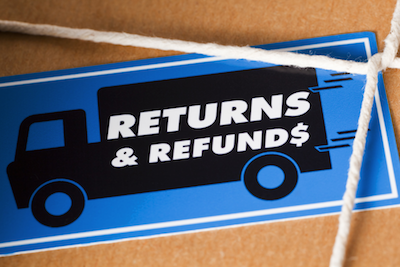When you have an e-commerce business, you know that you need to deal with returns and refunds.
The truth is that not everyone will be happy when receiving your products. However, there are best ways to deal with returns and refunds than others.
Discover everything you need to know about product returns.

To ensure that you maintain your customers happy and that you grow your business, make sure that you follow the next best practices for your e-commerce returns and refunds.
6 Best Practices For Your E-commerce Returns And Refunds
#1: Include Clear Deadlines:
In what concerns the best practices for your e-commerce returns and refunds, you want to ensure that your returns and refunds deadlines are clear.
Ultimately, your customers base their decision on buying from you in part due to your return and refund policy. So, you need to tell them exactly how you deal with returns and refunds in a clear way, especially in what concerns deadlines.
Take a look at these e-commerce website design tips.
#2: Accept Returns By Mail And Store:

In case you have a local store and also a website, you should allow your customers to make returns and ask for refunds on both mail and store. While some customers may prefer to go back to the store, others may prefer to do it via mail.
#3: Make Your Return Labels Easy To Print:
When a customer isn’t happy with the item he bought from you and wants to return it, just make things as easier as you can for it.
One common practice is to allow customers to print return labels. If you do have this option, you need to make sure that they can easily do it. After all, they didn’t like your item for a reason. So, you don’t need to make their life more difficult.
Check out the best practices for running a successful ecommerce website.
#4: Pay For The Return Shipping:

Yes, we know that shipping costs may be high. However, they are a part of your costs when you decide to have an e-commerce store.
When you are looking to build a relationship with customers, then you want to ensure that you offer free return shipping. The truth is that a customer will be more willing to buy from you if you have this option than if they need to pay for returning the products they don’t want anymore.
#5: Have A Good Return Policy In Place:
We can’t stress this enough. All e-commerce stores need to have a good return policy in place. In case you have no idea how to create one by yourself, then just copy on from other e-commerce retailers.
So, just pay a visit to some e-commerce sites you like and study their return policies. Steal the parts you like from successful online retailers to create your own e-commerce returns guidelines.
Discover the e-commerce trends you need yo know in 2020.
#6: Pay Attention To Your Profit Margins:

There’s no question that returns can erase your profit on sale items. So, you can simply exclude these products from the returning products list.
In addition, you need to make sure that your retail prices include enough margin to cover your operating expenses. The cost of returns is an operating expense, so include that in your pricing calculations.